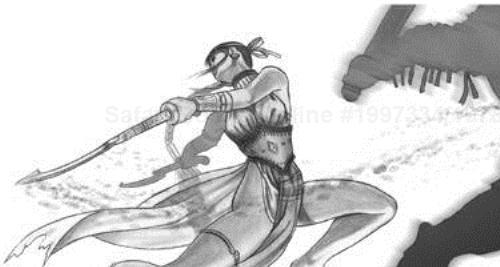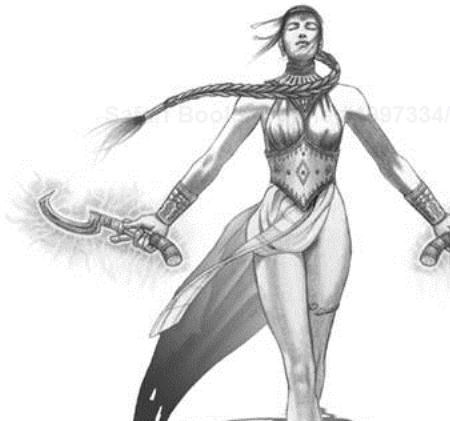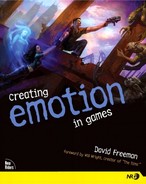Talk is cheap—and sometimes unnecessary.
This chapter focuses
on giving different facets to your characters, even if they have little or no dialogue in the entire game.
Sometimes you need to be able to portray a character—either a character you play or an NPC—as being multi-dimensional, even without dialogue. We've already seen how to do this when dialogue is used.
In previous chapters, we've talked at length about giving major NPCs a Character Diamond, which is a colorful combination of three to five Traits. (See Chapter 2.1, “NPC Interesting Techniques.”)
We also looked at ways to get a player to identify with a role that has, as part of it, different Traits. (See Chapter 2.19, “Role Induction Techniques.”)
One thing to keep in mind, whether the character is an NPC or one controlled by the player, is that the character's different facets or traits can sometimes be conveyed even without words.
This chapter doesn't contain techniques the way the other chapters do, but rather it focuses on applying principals learned elsewhere in the book to characters who don't speak or who rarely speak.
One of the games I worked on was Midway's Gladiator—The Crimson Reign. As sometimes happens in the game world, this game was cancelled before it was completed.
The game presented an interesting set of challenges. Consider just a few of them:
I had to create ten different characters from the height of the Roman empire—seven men and three women. These characters would all be gladiators. Most would be forced against their will to fight, although a few would elect to do so for their own reasons.
Each of these characters had to have unique personalities, quite distinct from one another. And each personality needed to be complex enough to intrigue a game player.
Each character needed to be someone the gamer would want to play.
While the game afforded opportunities for some very interesting use of voice-over, there were very few opportunities for the characters to talk. If I wanted to create Diamonds for each character, the challenges continued:
If each character had three to five Traits, at least three of these Traits needed to be able to be expressed nonverbally.
I had to repeat this for ten characters, and make each one of their clusters of personality Traits different from the other characters'.
The characters came from all over the Roman Empire. Their Traits could not violate what might be possible within their culture. Hopefully, their Trait cluster could perhaps even shed light on their culture.
If their Trait cluster was culturally based, it still couldn't be clichè. Their combinations of Traits needed to be colorful and fresh.
These seven requirements were a lot to pack in for ten different cultures, especially because most of the characters' personalities needed to be expressed nonverbally.
The challenge of creating these characters, and their Character Arcs, fell on my shoulders. However, the team, which was quite creatively adroit, quickly adopted my Emotioneering strategies and was able to make substantial contributions.
I'd like to suggest we take a look at one of the Gladiator characters in detail, but there's not a lot I can say about the character of Khensa. It's not that there isn't much to talk about. Rather, if I discussed her in detail, I'd inadvertently summon a harrowing midnight attack by vampiric game lawyers who'd swarm my bedroom and mummify me, wrapping me tightly in thousands of strips of paper made from copies of the non-disclosure agreement I signed with Midway.
This fate wouldn't be so bad if they'd then follow through and stick me in a colossal pyramid that people would visit with slack-jawed awe for thousands of years. The last time I checked, however, creating monuments so huge that they're visible from the moon falls outside of Midway's current business plan. So I'll be a bit conservative about sharing information on Khensa.
In the game, Khensa comes from Egypt. She's 18 years old, the youngest of the characters. Khensa was an apprentice in the temple to Isis and hoped to be a priestess some day. However, she was forced into a terrible choice:
She could marry the mayor of Alexandria, who lusts after her—but if she did, she'd betray her oath to the goddess Isis to never marry and to stay celibate. If she didn't marry the mayor, however, he vowed to burn down her beloved temple.
Or, she could avoid both of these fates and become a gladiator. In doing so, however, she would be forced to kill, which would violate her religious vows, not to mention her spiritual nature.
You might notice that Khensa has Rooting Interest (meaning we empathize with her), because her Undeserved Misfortune is a Rooting Interest Technique (see Chapter 2.10, “NPC Rooting Interest Techniques”).
I wanted to find five Traits to comprise Khensa's personality, and I wanted (as I did for all the characters) to have at least three that could be expressed without words.
The game offered a number of places a character could express himself or herself nonverbally:
The way the character greeted the crowd when entering an arena to fight. (The gladiator fights took place in many small and large arenas spread across the Roman Empire.)
The way a character taunted another warrior.
The way a character killed an opponent if that character was in a good mood.
The way a character killed an opponent if that character was in a bad mood.
The way a character exited an arena.
The possibilities for nonverbal expression multiplied when we decided that we'd give the characters more than one way to do most of the preceding.
The first two traits I picked were ones that required words to show. She was:
Innocent and Guileless. This could be shown nonverbally, of course, if we had the option of close-ups on her face. But that wasn't part of the plan except for some very brief cinematics. Primarily we saw her was when she was fighting in one or another arena.
Academically Astute. The most famous library of the ancient world was the renowned library at Alexandria. Khensa studied there in secret.
Her next three traits could be revealed nonverbally, but don't take my word for it. Take a look at three drawings of Khensa done by Cheryl Austin, the artist on the team who was responsible for the look of the main characters.
In these pictures, you see Khensa's remaining three of her five Traits. She was:
Sensual and Graceful.
Lonely.
Mystical, with some minor magical abilities.


If I and the artists and animators and programmers all did our work correctly, anyone who plays Khensa would feel she's a very dimensional character, even in the way she moves and fights.
And she's not just mystical, she also has some depth, for two of her five traits—lonely and mystical—are also Character Deepening Techniques.

Whether the characters you're designing are made to be played by the gamer or whether they're NPCs, take a look at:
The way they walk and run
Their fighting moves
Other ways they move
Their idles[1]
Other animations they might have
Their taunts
Their face
Their clothing
Their weapons
Their tattoos or other body markings
Their dwelling, if they have one
How many of these forms of non-verbal communication can you use to express traits on the character's Diamond?
